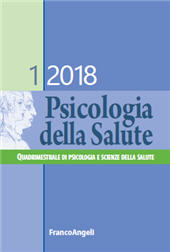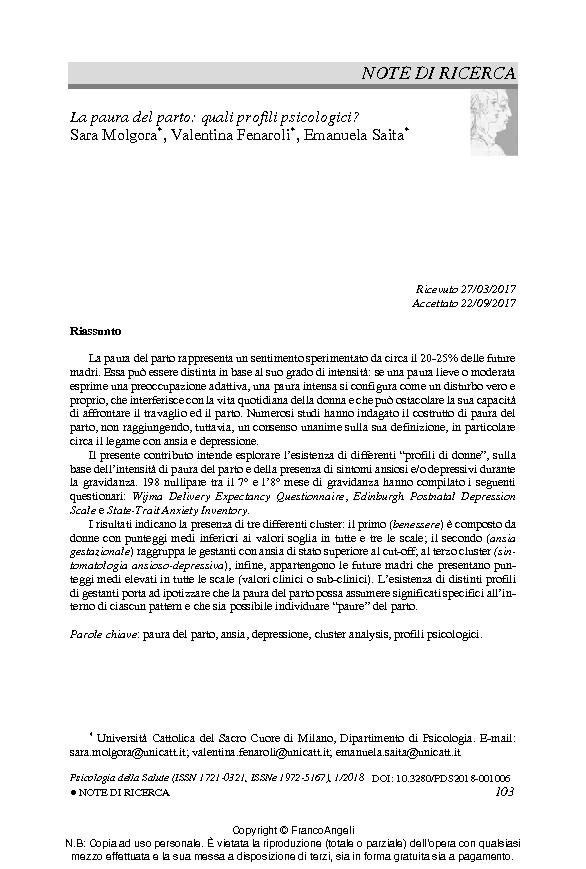La paura del parto : quali profili psicologici?
103-115 p.
La paura del parto rappresenta un sentimento sperimentato da circa il 20-25% delle future madri. Essa può essere distinta in base al suo grado di intensità: se una paura lieve o moderata esprime una preoccupazione adattiva, una paura intensa si configura come un disturbo vero e proprio, che interferisce con la vita quotidiana della donna e che può ostacolare la sua capacità di affrontare il travaglio ed il parto. Numerosi studi hanno indagato il costrutto di paura del parto, non raggiungendo, tuttavia, un consenso unanime sulla sua definizione, in particolare circa il legame con ansia e depressione. Il presente contributo intende esplorare l'esistenza di differenti "profili di donne", sulla base dell'intensità di paura del parto e della presenza di sintomi ansiosi e/o depressivi durante la gravidanza. 198 nullipare tra il 7° e l'8° mese di gravidanza hanno compilato i seguenti questionari: Wijma Delivery Expectancy Questionnaire, Edinburgh Postnatal Depression Scale e State-Trait Anxiety Inventory.
I risultati indicano la presenza di tre differenti cluster: il primo (benessere) è composto da donne con punteggi medi inferiori ai valori soglia in tutte e tre le scale; il secondo (ansia gestazionale) raggruppa le gestanti con ansia di stato superiore al cut-off; al terzo cluster (sintomatologia ansioso-depressiva), infine, appartengono le future madri che presentano punteggi medi elevati in tutte le scale (valori clinici o sub-clinici). L'esistenza di distinti profili di gestanti porta ad ipotizzare che la paura del parto possa assumere significati specifici all'interno di ciascun pattern e che sia possibile individuare "paure" del parto. [Testo dell'editore].
Fear of childbirth is a feeling experienced by as much as 25% of future mothers. It can be distinguished by its degree of perceived and actual intensity in facing labor. A mild or moderate fear is adaptive, while intense fear has the potential to develop into a full disorder, interfering with the woman's daily life and with her capacity to face labor. Numerous studies have investigated the construct of fear of childbirth, but have not yet reached a unanimous consensus on its definition, especially as it relates to anxiety and depression. The present research explores the existence of different "women's 'profiles'" based on the intensity of fear of childbirth and the presence of anxious or depressive symptoms during the pregnancy.irst-time mothers between the 7th and 8th month of pregnancy completed the Wijma Delivery Expectancy Questionnaire, Edinburgh Postnatal Depression Scale, and State-Trait Anxiety Inventory.
The results indicated the presence of three distinct clusters. The first cluster, that we call well-being, is composed of women with average scores lower than the threshold values on all three measures. The second, pregnancy anxiety, groups women with a mean state-anxiety score above the cut-off. To the third cluster, anxiety-depressive symptoms, belongs mothers-to-be who have high average scores on all scales. The existence of distinct pregnancy profiles suggests that childbirth can assume specific meanings within each pattern and that it is possible to identify different "fears" of childbirth. [Publishers' text].
Fait partie de
Psicologia della salute : quadrimestrale di psicologia e scienze della salute : 1, 2018-
Articles du même numéro (disponibles individuellement)
-
Informations
Code DOI : 10.3280/PDS2018-001006
ISSN: 1972-5167
DISCIPLINES
KEYWORDS
- Paura del parto, ansia, depressione, cluster analysis, profili psicologici
- Fear of childbirth, anxiety, depression, cluster analysis, psychological profiles



